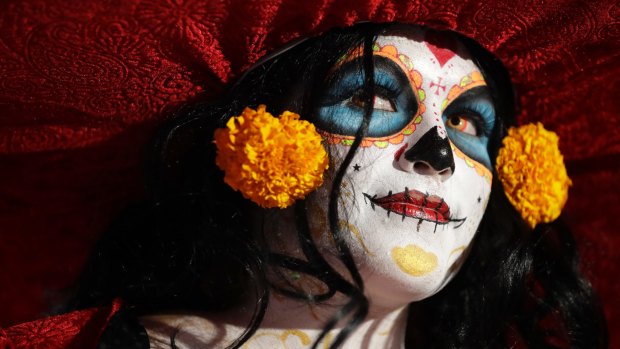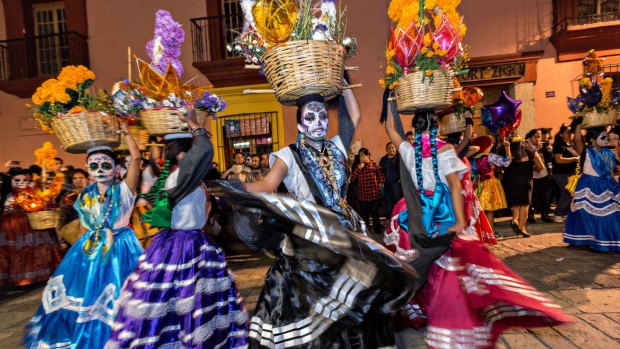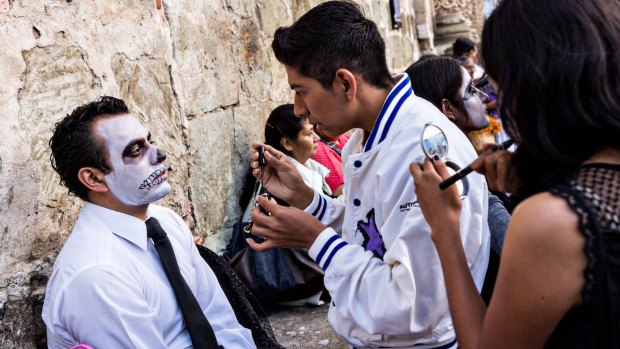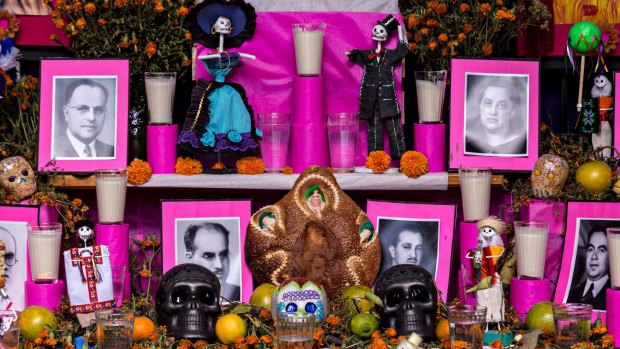This was published 5 years ago
Mexico's Day of the Dead travel guide and things to do: What it's like to attend Mexico's Dia de los Muertos

A woman dressed as Mexico's iconic 'Catrina' awaits the start of the grand procession of the Catrinas, part of the Day of the Dead celebrations in Mexico City.Credit: AP
It is 10 pm when we enter the small cemetery of XoXocotlan on the outskirts of Oaxaca (pronounced "wha-haa-ka") in south-east Mexico. Every grave is decorated with candles, the amber glow illuminating the faces of those gathered. Many are in groups, laughing and sharing tequila, others sit in twos and threes strumming guitars and singing quietly, and some are alone, praying in silence.
Far from being morbid Mexico's Dia de los Muertos, or Day of the Dead, is a time to honour the departed, to celebrate their lives and to acknowledge that death is a part of life. Most importantly, it is not a Mexican version of Halloween. While Halloween is a fright-night of tricks and treats, Day of the Dead is a multi-day, life-affirming celebration, so revered that in 2008 UNESCO inscribed the festival on its list of "Intangible Cultural Heritage of Humanity".
To learn more I've joined G Adventures-National Geographic Journeys for a seven-day Day of the Dead tour based in Oaxaca, a largely indigenous region where traditions are still intact.

Costumed dancers at a Comparsa, or parade, during the Day of the Dead festival.Credit: Alamy
IN THE BEGINNING
Aspects of Day of the Dead began 3000 years ago amid Mexico's pre-Hispanic cultures, with festivals dedicated to the goddess of the underworld, Mictecacihuatl. When the Spanish conquistadors arrived, along with their Christian beliefs, they moved the date to coincide with the Catholic holiday of All Saints' Day on November 1 and All Souls' Day on November 2. They also introduced sugar skeletons in place of the real thing.
Even so, the central belief has remained unchanged – Day of the Dead is a celebration of life. "The deceased would be insulted if we mourned them," guide Andrea Betanzos explains. "Death is not the end, it is just the journey to the next stage of life."

Mexicans have scary make-up applied to take take part in the Day of the Dead festival in Oaxaca.Credit: Alamy
'ALTARED' STATES
The heart of the celebration is an ofrenda or altar, a three-tiered construction built in family homes, public spaces and cemeteries in the week leading up to November 1. Signifying heaven, earth and the underworld it is designed to entice the wandering spirits back for their brief rendezvous with the living. The main components include copal incense to clear the air, marigolds to lead the way, bread for the dead as a treat after the arduous journey, special foods the deceased once enjoyed, photos and possessions.
"The departed are still considered members of our community," Betanzos says. "When their souls return to earth it is our chance to come together once again as a family."

An altar, or ofrendas, set up to celebrate the Day of the Dead festival.Credit: Alamy
Skulls are a key component. Dipped in glitter, decorated with colourful icing and sometimes inscribed with the deceased person's name, these calavera de azucars are a reminder of the inevitability of death. While the sugar ones are not for eating you can buy chocolate or biscuit ones from the markets as a reminder of the sweetness of life.
Over the days the streets fill with altars, some are decorated with cakes and fruits, others with beers and baseball caps. All are lovingly tendered and refreshed daily.
"The dead are always with us," Betanzos says. "But this is the time we feel their spirits most keenly."
That night, alone in my room I feel my mother's touch on my cheek, later I am woken to the voice of my grandmother calling my name.
DEM BONES
Street parades, as colourful and noisy as fireworks, explode across the cobbled laneways each evening. One day it is school children dressed as anything from Dracula to Frankenstein, on another it's pooches, their glow-in-the-dark bones leading the way. The most enchanting are the ethnic groups, their costumes, music and dance representing the 16 different clans of Oaxaca.
One of the more modern characters is La Calavera Catrina or Le Catrina, a high-society skeleton lady based on an illustration by Mexican lithographer Jose Guadalupe Posada (1852-1913). Originally created as political satire this grand dame of the dead reminds us we are all equal in death.
Before you start shaking your maracas and dancing a jig behind the mariachi band be warned; it's early days and you need to pace yourself for the main parade. Instead, find a bar with an upstairs balcony, order a margarita and watch the spectacle from above as the setting sun turns Oaxaca's buildings into burnished gold.
MAGIC IN THE HILLS
The daily parades are just one piece of the festival puzzle; the rest is held together by magic. It's day three when we head to Capulalpam de Mendez, a traditional Oaxacan town designated as one of Mexico's "magical" towns. Tucked high in the Sierra Madre Oriental this 1200-year old village continues to maintain its Zapotec culture. At the invitation of the local Curandero, or female shaman, we undergo a "Limpia" cleansing, an important ritual in the lead-up to the Day of the Dead. Herbs are burned, eggs are cracked, sugar cane rum is drunk (and spat) and I am free of all bad spirits.
A visit to the village of San Martin Tilcajete, famous for its hand-painted figurines known as alebrijes, provides a second level of security. Using my birthdates, a series of complex calculations are performed against a traditional calendar (where 20 days are represented by 20 animals) to determine my "animal protector" and "animal personality". I leave with a small jaguar in one pocket and a chameleon in the other. You can never be too sure.
GRAVE SECRETS
It is believed the souls of departed children or los Angelitos (little angels) return on the night of October 31, with the spirits of adults arriving the following evening. In traditional regions such as Oaxaca families set up all-night cemetery vigils on both dates.
In XoXocotlan cemetery our small group is welcomed; with candles to place on those graves without visitors and mugs of hot chocolate or home brew. The atmosphere is sociable but subdued. "The music and fireworks are not so much about partying," Betanzos says. "But about making enough noise to show the spirits the way back from the underworld."
NIGHT OF THE LIVING DEAD
November 1 is party night. We spend the day shopping for costumes in the markets and having our faces painted before heading to a small village in Etla Valley. The sun is setting as we fall into step behind a mariachi band, joining clowns and Catrinas, vixens and vampires as we thread our way through the colourful streets.
Over the next two hours the parade takes on a life of its own, writhing like a rainbow serpent and drawing people from their homes as we march towards the village square. Tequila is shared and locals open their doors to outsiders who may need a bathroom stop or glass of water. On this night we are united as one; to remember those we have loved and lost and to celebrate the most fleeting of gifts – life itself.
TRIP NOTES
MORE
FLY
United Airlines flies directly from Sydney to Houston, USA (or via Los Angeles from Melbourne) with connections to Oaxaca, Mexico. united.com
TOUR
G Adventures offers a seven-day Day of the Dead tour coinciding with the annual festival in Oaxaca, Mexico. Prices start from $A1599 a person, twin-share excluding airfares. gadventures.com.au
Kerry van der Jagt travelled with the assistance of United Airlines, but paid her own way for the G Adventures tour.
Sign up for the Traveller Deals newsletter
Get exclusive travel deals delivered straight to your inbox. Sign up now.